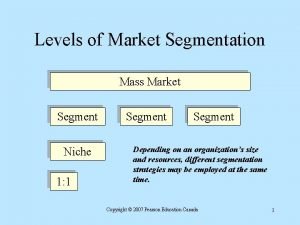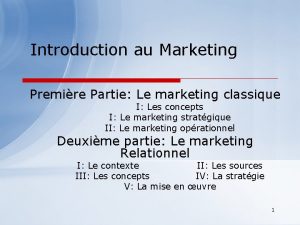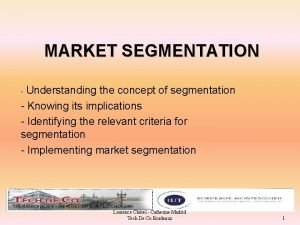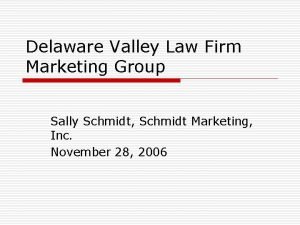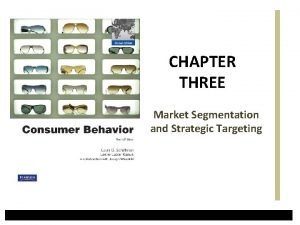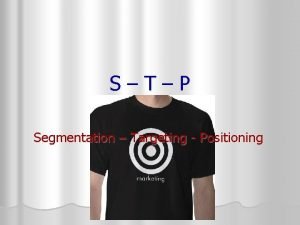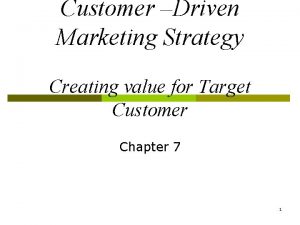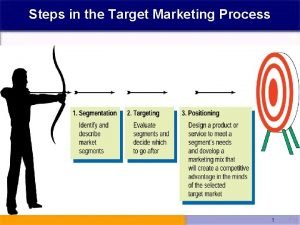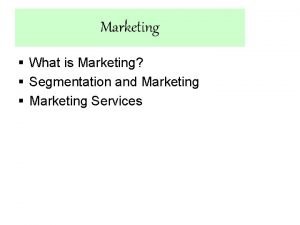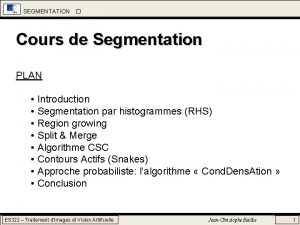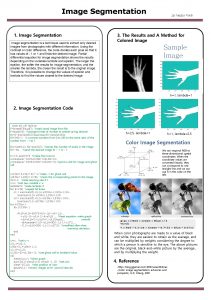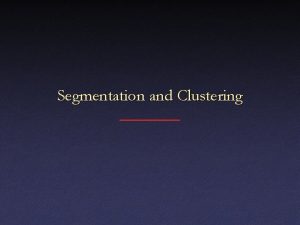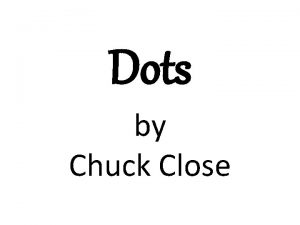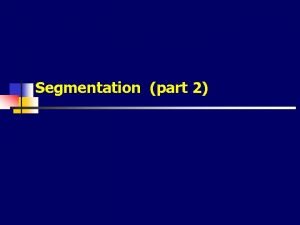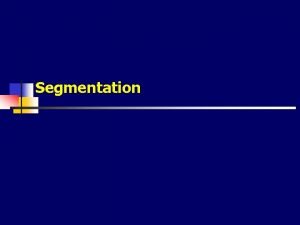8 Segmentation Target Marketing Dr Close Finding Markets


























- Slides: 26

8 Segmentation & Target Marketing Dr. Close

Finding Markets • Markets = people with needs/wants and the ability and willingness to buy • Types of markets: – Generic • People with broadly similar needs (social) • Diverse ways of satisfying (restaurants, movies) – Products • Very similar needs (thirsty for soft drinks) • Very close substitutes (Coke vs. Pepsi, and what else? ) Close substitutes or no?

Pepsi vs Coke

What’s the Difference? Market Segment People or organizations with needs or wants and the ability and willingness to buy. A subgroup of people or organizations sharing one or more characteristics that cause them to have similar product needs. The process of dividing a market into Market meaningful, relatively similar, identifiable Segmentation segments or groups.

Market Segmentation • Dividing market into meaningful, similar groups (or aggregating those with similar needs) • Why is segmentation important? . . • Markets have a variety of product preferences • Marketers can better define customer needs • Decision makers can define objectives and allocate resources more accurately

Criteria for Segmentation Substantiality Segment must be large enough to warrant a special marketing mix. Identifiability and Measurability Segments must be identifiable and their size measurable. Accessibility Members of targeted segments must be reachable with marketing mix. Responsiveness Unless segment responds to a marketing mix differently, no separate treatment is needed.

So, A Good Segment is… • Homogenous within: members are similar • Heterogeneous between: outsiders differ (choose the best) • Substantial: large enough for profit (Ned Flanders) • Operational: workable (identify then access China)

Bases for Segmenting Markets Geography • Region • Market size • Market density • Climate Demographics • • • Age Gender Income Ethnicity Family life cycle Psychographics • • Personality Motives Lifestyle Geodemographics Benefits • Benefits sought Usage Rate • • Former Potential 1 st time Light or irregular • Medium • Heavy

Demographic Segmentation: Family Life Cycle

Psychographic Segmentation • • Personality (cars) Motives (emotions) Lifestyles (outdoor) Geodemographics (PRIZM)

Benefit Segmentation • Group consumers via needs/wants (NOT by gender, age, lifestyle etc. ) • What do you want from your cell phone?

Usage Rate Segmentation • • • Group by amount/rate of consumption Former apple users Potential apple users Light apple users Heavy apple users 80/20 principle of demand

6 Steps to Segment a Market Select a market for study Choose bases for segmentation Select descriptors Profile and analyze segments Select target markets Design, implement, maintain marketing mix

Strategies for Selecting Target Markets Options… – Undifferentiated Targeting • One market, one mix (plain toilet paper) • Any other examples? – Concentrated Targeting • Multiple markets & mix for each • Examples include Ford, Lincoln, Mercury, and what else? – Multi-segment Targeting • Multiple markets share mix (bad idea) • Advantages = Greater financial success; Economies of scale Disadvantages= High costs; Cannibalization

Strategies for Selecting Target Markets • Options – Undifferentiated Targeting • One market, one mix (plain toilet paper) • Any other examples? – Concentrated Targeting • Multiple markets & mix for each • Examples include Ford, Lincoln, Mercury, and what else? – Multi-segment Targeting • Multiple markets share mix (bad idea) • Example: network television and any more?

One-to-One Marketing is. . . Has a Goal of… Individualized Cost Reduction Information-Intensive Customer Retention Long-Term Increased Revenue Personalized Customer Loyalty

One-to-One Marketing Trends • One-size-fits all marketing is lame. • Direct/personal marketing will grow to meet needs of busy consumers. • We will be loyal to companies that have earned—and reinforced—our loyalty. • Mass-media approaches will decline as technology allows better customer tracking.

Marketing Strategy • • Matching opportunity with resources and business objectives Goals: 1. SCA • • Enduring superiority of a business BEST: from many parts (Wal-Mart) 2. Breakthrough opportunity • Conditions right for SCA

Positioning Developing a marketing mix to influence potential customers’ overall perception of a brand, product line, or organization in general. How is Wal-Mart Positioned?

Positioning Bases Attribute Price and Quality Use or Application Product User Product Class Competitor Emotion

Positioning of Procter & Gamble Detergents Brand Positioning Tide Cheer Bold Gain Era Dash Oxydol Solo Dreft 9 Ivory Snow LO Ariel Tough, powerful cleaning Tough cleaning, color protection Detergent plus fabric softener Sunshine scent, odor-removing Stain treatment and stain removal Value brand Bleach-boosted formula, whitening Detergent and fabric softener in liquid form Cleaning for baby clothes, safe Fabric & skin safety on baby clothes Tough cleaner, aimed at Hispanic market Market Share 31. 1% 8. 2% 2. 9% 2. 6% 2. 2% 1. 8% 1. 4% 1. 2% 1. 0% 0. 7% 0. 1%

Effective Positioning 1. Assess the positions occupied by competing products 2. Determine the dimensions underlying these positions 3. Choose a market position where marketing efforts will have the greatest impact

Product Differentiation A positioning strategy that some firms use to distinguish their products from those of competitors. Are distinctions real or perceived?

Perceptual Mapping

Daimler Chrysler: Do they need a reposition? (Changing consumers’ perceptions of a brand in relation to competing brands)

Summary • • • Generic vs product markets Segmentation: Criteria Bases for segmenting Strategies of segmentation (effective)Positioning/repositioning, bases Any questions?
 Target market and channel design strategy
Target market and channel design strategy Steps in market segmentation targeting and positioning
Steps in market segmentation targeting and positioning Primary target market and secondary target market
Primary target market and secondary target market Marketing strategies for emerging markets
Marketing strategies for emerging markets Requisites of sound marketing segmentation
Requisites of sound marketing segmentation Segmentation ciblage positionnement marketing
Segmentation ciblage positionnement marketing Segmentation ciblage positionnement coca cola
Segmentation ciblage positionnement coca cola Segmentation de niche
Segmentation de niche Stratégie de segmentation marketing
Stratégie de segmentation marketing Market segmentation and positioning
Market segmentation and positioning Principles of market targeting
Principles of market targeting Segmentation
Segmentation Marketing segmentation tree
Marketing segmentation tree Bssu
Bssu Global market segmentation
Global market segmentation Micro segmentation
Micro segmentation Carte perceptuelle marketing
Carte perceptuelle marketing Law firm marketing group
Law firm marketing group Consumer rooted segmentation
Consumer rooted segmentation Stp marketing
Stp marketing Target market criteria
Target market criteria Vals typology of market segmentation
Vals typology of market segmentation Marketing segmentation
Marketing segmentation Target marketing strategies
Target marketing strategies Creating value for target customers
Creating value for target customers Target marketing process steps
Target marketing process steps Focused targeting strategy
Focused targeting strategy







